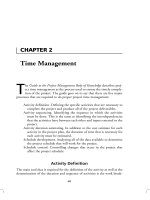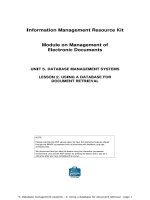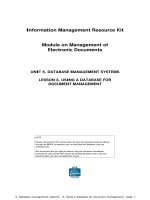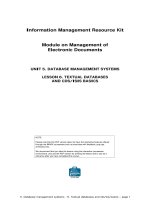Lecture Database management systems Chapter 2 Entity relationship model
Bạn đang xem bản rút gọn của tài liệu. Xem và tải ngay bản đầy đủ của tài liệu tại đây (904.2 KB, 34 trang )
Chapter 2
Entity Relationship
Model
Introduction
Modeling databases using a graphical
technique is proposed so that humans can
relate to easily.
ER Model is based on a perception of a
real world that consists of collection of
basic objects called entities and
relationships among these objects.
Overview of Database Design
Conceptual design: (ER Model is used at this
stage.)
A database “schema” in the ER Model can be
represented pictorially (ER diagrams).
The next step in DB design is the actual
implementation of the database, using a
commercial DBMS
By using the DBMS, conceptual design from
high-level data model will be transformed into the
implementation data model.
COMPANY example
The COMPANY database keeps track of
company’s employee, departments, and
projects
Suppose that after the requirement
collection and analysis phase, the database
designers provide the following
description:
COMPANY example
The company is organized into
DEPARTMENTs.
Each department has a name, number and an employee
who manages the department.
The start date of the department manager will be kept
track. A department may have several locations.
Each department controls a number of
PROJECTs.
Each project has a unique name, unique number and is
located at a single location.
COMPANY example
We store each EMPLOYEE’s name social
security number, address, salary, sex, and
birthdate.
Each employee works for one department but may
work on several projects.
We keep track of the number of hours per week that an
employee currently works on each project. We also
keep track of the direct supervisor of each employee.
Each employee may have a number of
DEPENDENTs.
For each dependent, we keep track of their name, sex,
birthdate, and relationship to the employee.
ER Model Basics
ER model describes data
relationships, and attributes
as
entities,
Entity:
an object that exists and is
distinguishable from other objects. In other
words, the entity can be uniquely identified.
◦ Ex:
A particular person, for example Dr. Alain is an entity.
A particular department, for example CSE faculty.
A particular place, for example HCM city can be an
entity.
ER Model Basics
Entity type or entity set: collection of
similar entities
◦ Ex:
All students in CSE, say STUDENT.
All courses in CSE, say COURSE
An entity may belong to more than one
entity type.
◦ Ex: The same person is a LECTURER at one
instance and STUDENT at another instance.
ER Model Basics
Relationship: associations among two or
more entities
Ex:
◦ An Dang works in Pharmacy department.
◦ Teaches is the relationship type between
LECTURER and STUDENT.
Symbols Used in ER Diagram
Entity sets
Attributes
Relationships
ER Model Basics
Attributes: properties of entity
Ex: Roll number, name, and grade are the
attributes of STUDENT.
Attribute classification
1
Attribute classification
Single Value Attribute: only one value
associated with that attribute.
◦ Symbol for Single Value Attribute:
◦ Ex
STUDENT
FullName
Attribute classification
Multivalued Attribute: more than one
value will be associated with that
attribute.
◦ Symbol:
Skills
◦ Ex:
EMPLOYEE
Name
Attribute classification
Derived Attribute:
◦ Can be computed from other attributes
◦ Symbol:
◦ Ex: Age of a person can be derived from the
date of birth of the person
Age
PERSON
Name
Attribute classification
Composite Attribute
ER Diagram
Key attribute
An important constrain on the entities of
an entity type is the KEY on attributes
An attribute of an entity type for which
each entity must have a unique value is
called a key attribute of the entity type.
For example, SSN of EMPLOYEE.
Each key is underlined
Relationship degree
Unary Relationship (recursive
relationship):
◦ In the unary relationship the number of
associated entity is one. An entity related to
itself is known as recursive relationship.
PLAYER
Captain of
Relationship degree
Binary Relationship: two entities are
involved.
Staff
Is assigned
Department
Relationship degree
Quaternary Relationship: two entities are
involved.
Location
Staff
Is assigned
Department
Relationship degree
Quaternary Relationships: involve 4
entities
SLIDES
PROFESSOR
Teaches
COURSE
STUDENT
Relationship Classification
One-to-Many Relationship Type:
◦ The relationship that associates one entity to
more than one entity is called one-to-many
relationship.
◦ Symbol:
◦ Example: parent–child relationship. For one
parent there can be more than one child.
DEPARTMENT
EMPLOYEE
Relationship Classification
One-to-One Relationship Type:
◦
◦
◦
◦
a special case of one-to-many relationship.
True one-to-one relationship is rare.
Symbol:
Ex: The relationship between the President
and the country is an example of one-to-one
relationship.
PRESIDENT
COUNTRY
Relationship Classification
Many-to-Many Relationship Type
◦ Ex: The relationship between students and
courses.
◦ Symbol:









